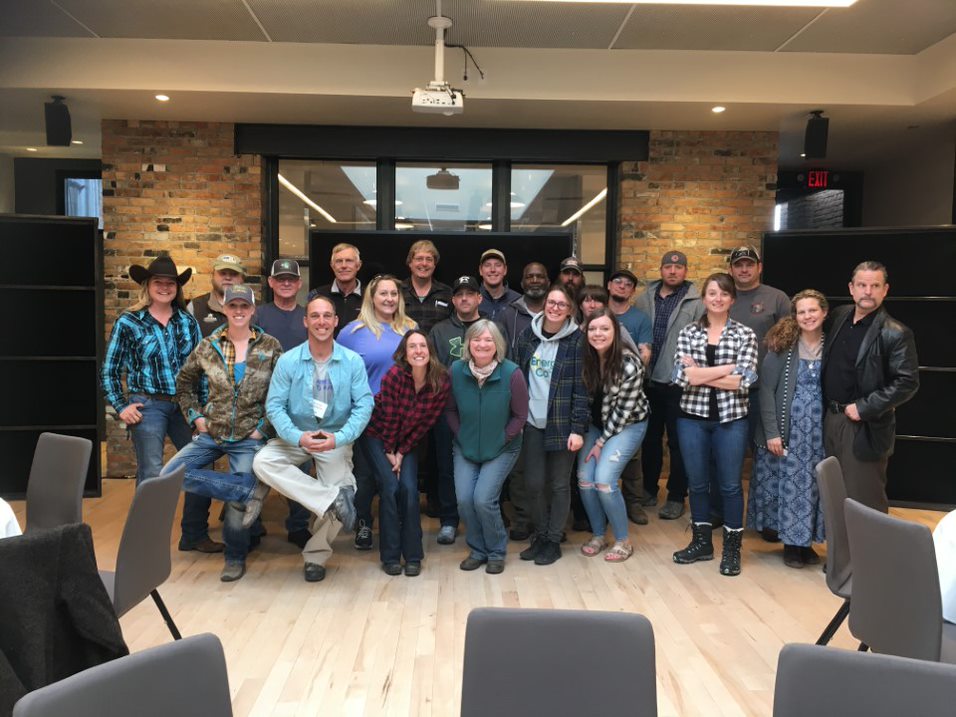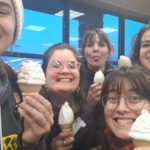By Madelynn Nelson
What is Armed to Farm? That was the question in my head when I accepted my position as the Armed to Farm Sustainable Agriculture Educator with the Montana Energy Corps. What am I arming farmers with? How am I arming them? I was lost in a sea of confusion. After three months of serving with Tammy Howard at the NCAT Headquarters to plan the Rocky Mountain West training, I understood the meaning behind Armed to Farm.
Armed to Farm is Sustainable Agriculture Training for Military Veterans. The goals of Armed to Farm are to train veterans and their families to operate sustainable crop and livestock enterprises, create a network of veterans and families who are starting careers in sustainable agriculture, and provide technical assistance to participants as they start and improve their farming operations.
This is a weeklong training held in different regions throughout the US through our different NCAT regional offices While working in Butte, we collaborated with the hotel and venue in Bozeman on catering and logistics, rented vans to carry fifteen passengers, contacted experts on various agricultural subjects to present at the training, worked with farmers to set up tours and additional presentations and finally, sifted through applications to select the best-fitting participants.
Tammy wanted me to be as involved as possible in the planning for this event. Armed to Farm has a basic curriculum that all of its regions follow, but differs in ways that are site specific. My task was to add a topic to the curriculum that I thought would be beneficial for beginning farmers to learn about. After reviewing existing resources and materials, I suggested a topic on water in the west – irrigation, water rights and how to properly manage water on their property. Tammy agreed and set me on the road of finding resources and setting up a speaker.
In February, I attended the Greater Yellowstone Agriculture Forum to learn more about the subject myself. Appropriately, the theme for this year’s forum was Water Rights 101. Most people at this event were ranchers who wanted to know more about house and senate bills that were going through and how it was going to affect them. I was sitting by myself, taking notes like crazy because this was all foreign to me. I knew water quantity was an issue out here in the west, but I had no idea about how deep the well was.
After this event, my biggest task was to set up a speaker for water rights. I was given the contact of a lawyer on water rights by a colleague in the office, sent her an email, and almost immediately got a response from her agreeing to be a part of this event. When I sent her the first email, I was so nervous and had almost everyone in the office proof read it before I hit send. Needless to say, I was both relieved and excited when she responded in agreement.
With the Goliaths now conquered, it was time to hammer down and make sure everything else was ready for the event. A week before the event, I finalized names with the hotel to get everyone their rooms and numbers for the catering. Tammy and I were checking the weather and trying our best to prepare everyone for the rainy week we had in store. We double checked with all of our presenters and confirmed dates and times and then everything was ready to go.
On Sunday night, we picked up the rental vans for the week and got everything ready to go. We checked into the hotel and then game planned for the week ahead of us, mapping out best routes for the farm tours we would be visiting most afternoons.
Monday morning came and we were ready with our resources spread out and our registration table set up. People came trickling in, grabbing breakfast and immediately engaging with one another. Once everyone was settled in, we started off with introductions and jumped right into goal setting. I sat in the back observing as Tammy was showing them all these resources that were available to them and how she set her goals up when she first started out and explained to them how it’s okay for your goals to change as you move forward.
From there, the week chugged right along. Every morning started out with classroom sessions, which ranged from goal setting, marketing and business planning to water resources and soil assessments.
Our first presenter, Rachel, talked about water rights in Montana and showed the group how to find water rights on their property. This was definitely a topic that intrigued everyone and something everyone in the west needed to know. They had tons of questions for Rachel and provided good conversation throughout the day. Rachel showed them in her presentation how to find water rights on your property, how to file a claim for water rights, and how to monitor how the people around you are using their water rights.
We also had a presentation from the local NRCS office, where they showed the benefits of using cover crops to reduce water runoff and increase infiltration. This was a very interactive presentation and it went over so well with the group. There were tons of questions on how to improve their soil health and what types of cover crops to plant that went best with the enterprises they were wanting to engage in.
Afternoons were saved for field trips to local farms for a more hands on approach of farming. This was most people’s favorite part because this was where they could see how others implemented ideas and made things work for their farms. All of the farms were diverse, from the types of fruits and veggie production to the livestock operations that took place, so there was something for everyone. The only downside to these field trips was that the weather did not cooperate with us at all. The first two days were rainy and cold and on Wednesday we woke up to snow.
On Thursday, we lucked out with a beautiful day. We spent the whole day on farm tours, starting off at NCAT’s Ag Specialist Dave Scott’s sheep farm. Dave gave us a tour of his farm and talked about lambing, showed us some lambs and things to watch for when lambing. He also talked about sustainable grazing practices and how important soil health is. After Dave’s presentation, he showed us a fencing demo on how he moves his sheep every day so that the grass has time to grow and not get compacted and eroded.

After Dave’s farm, we went to Montana Cross Farm, run by Armed to Farm Alumni, Van and Heather Puckett. They have an Icelandic sheep farm that they run completely off the grid using wind and solar energy. They talked about their system and showed the group around the farm to see how they have it set up. Heather talked about how the success of their farm came about from deciding to use every part of the sheep and letting nothing go to waste. When a lamb is purchased for meat, they sell the wool and the horns as well.
Visiting Van and Heather’s farm was extremely beneficial for the group because they got to see an Armed to Farm success story. They were able to ask questions about starting up a farm, running into obstacles and how to overcome them. They also learned a lot about value added to their products, as the Puckett’s sell wool rugs dyed different colors, wool dryer balls, and other wool products.

We ended Thursday with a barbeque at the Puckett’s farm – the menu consisting of lamb, a spring salad, pasta salad, bread, brownies and juice. It was a delightful meal and a great bonding time for the whole group. Everyone shared what their favorite parts of the training was and how they would continue to stay in contact with one another. Some people talking about working with one another and others were really excited to share what they had planned for their farm.
All in all, it was a great week for sustainable farm training. The group was great and got along well, had a great time visiting the farms and networking – not only with one another, but with the farmers who let us visit their farms as well.
One thing I really enjoyed about this training was watching these veterans step out of their comfort zone to participate in this event, ask questions, and show determination to succeed in their farming enterprises. I saw a lot of hesitation at the beginning of the week that seemed to go away and turn into motivation by the end of the week. But if I’m being honest, my favorite part was the baby animals I got to cuddle. 🙂










